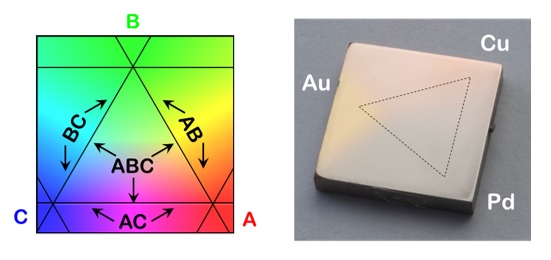CSAF Preparation and Characterization
Xiaoxiao Yu, Matthew Payne, Por Katanyutanon
Multicomponent metal alloys play an essential role in many technologies and their properties must be optimized by rational selection of the alloy's components and its fractional composition of each. The experimental approach to searching for the composition that optimizes a desired property can be time-consuming, requiring the preparation and characterization of a large set of discrete samples. High-throughput materials synthesis allows us to prepare Composition Spread Alloy Films (CSAFs), sample libraries that contains all possible compositions of a binary or ternary alloy, AxByC1-x-y with x = 0 → 1 and y = 0 → 1-x (Figure below). In our lab, a Rotatable Shadow Mask (RSM) - CSAF deposition tool has been developed for the creation of CSAFs containing up to four components selected from almost any of the metallic elements [1]. Such CSAFs can be prepared with composition gradients and/or thickness gradients in arbitrarily controlled directions and on a variety of substrates. By annealing CSAFs that are initially deposited with thickness gradients on non-wetting substrates, we can also create high-throughput libraries of nanoparticles with size gradients in one direction and composition gradients in another; Size and Composition Spread NanoParticle (SCSNaP) libraries.

Once prepared, the CSAF libraries can be characterized thoroughly using a variety of high-throughput spectroscopic methods. Their bulk composition is mapped across the library using Energy Dispersive Spectroscopy (EDS). Bulk phases can be mapped across composition space using Electron Back Scatter Diffraction (EBSD). The near-surface and topmost-surface compositions are mapped across composition space using X-ray Photoemission Spectroscopy (XPS) and Low Energy Ion Scattering Spectroscopy (LEISS), respectively [2]. Finally, the electronic structure can be mapped using UV photoemission spectroscopy (UPS) and valence band x-ray photoemission spectroscopy. Once characterized, these CSAFs are being used in our laboratory for high-throughput studies of alloy catalysis [3] and alloy corrosion [4]. CSAFs are also provided to our collaborators for measurements of various other properties of the alloys and of alloy-substrate interfaces. The key value to these CSAF libraries is that they enable measurement of important alloy properties across entire binary or ternary alloy composition spaces, without the need to prepare and characterize numerous discrete composition samples.
Related Publications
Coming Soon.
References
- B. Fleutot, J.B. Miller, A.J. Gellman, "Apparatus for deposition of composition spread alloy films: The rotatable shadow mask" Journal of Vacuum Science and Technology - A ; 2012, 30(6), 061511-1-10 . View paper
- D. Priyadarshini, P. Kondratyuk, Y.N. Picard, B.D. Morreale, A.J. Gellman, J.B. Miller, "High-Throughput Characterization of Surface Segregation in CuxPd1-x Alloys" Journal of Physical Chemistry C ; 2011 , 15, 10155-10163 . View paper
- G. Gumuslu, P. Kondratyuk, J.R. Boes, B. Morreale, J.B. Miller, J.R. Kitchin, A.J. Gellman, "Correlation of electronic structure and H2-D2 exchange activity across CuxPd1-x composition space" ACS Catalysis; 2015, 5, 3137?3147 . View paper
- M.A. Payne, J.B. Miller, A.J. Gellman, "High-throughput characterization of early oxidation across AlxFeyNi1-x-y composition space" Corros. Sci. ; 2015 , 91, 46-57. View paper